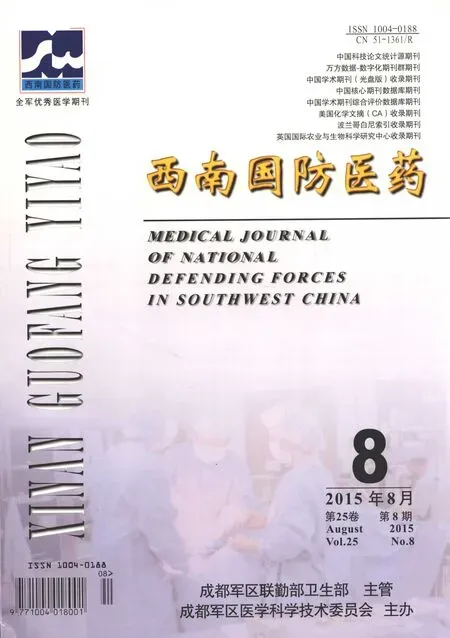口腔癌患者术后短期细胞免疫功能的变化
符良斌,廖天安,王鸿,邓伟,胡广伟
口腔癌患者术后短期细胞免疫功能的变化
符良斌,廖天安,王鸿,邓伟,胡广伟
目的探讨口腔癌患者术后短期细胞免疫功能的变化。方法选取2014年1月~2015年1月来我科行手术根治的口腔癌患者27例,术前均经病理证实为唾液腺癌或鳞状细胞癌,通过流式细胞仪检测患者在根治手术前及术后1~2 w外周血中T淋巴细胞亚群的变化。另以同期来我院体检中心体检的健康人外周血淋巴细胞亚群检测结果作为正常参考值。结果术前患者的CD3+细胞和CD3+CD4+细胞分别为(65.4±8.6)%和(30.3±6.1)%,均显著低于正常参考值(P<0.05);但在术后,随着时间延长,CD3+细胞和CD3+CD4+细胞呈增加趋势,术后2 w分别为(71.4±6.2)%和(36.7±6.5)%,显著高于术前(P<0.05)。术前NK细胞明显低于正常参考值,在术后1 w时也有所下降,但随着术后时间的延长,NK细胞的含量有所回升,并逐渐恢复至正常。术前患者CD3+CD8+细胞为(43.9±5.7)%,高于正常参考值(38.4±4.1)%;但在术后随时间延长而下降,在术后2 w为(40.9± 6.9)%,显著低于术前(P<0.05)。CD4+/CD8+细胞比值在术前为0.7±0.5,术后2 w时为1.5±0.6,显著高于术前(P<0.01)。结论口腔癌患者细胞免疫功能受到一定的抑制,手术治疗可以有效缓解细胞免疫抑制作用。
口腔癌;免疫功能;手术治疗
口腔癌是发生在口腔的恶性肿瘤的总称,病理表现主要是鳞状上皮细胞癌。目前,口腔癌的发病机制尚不十分清楚,其治疗主要以手术为主,辅以全身化疗和局部放疗的综合治疗[1]。然而手术治疗可能影响机体的免疫功能[2],但是对细胞免疫功能的影响尚不完全清楚。本研究探讨了口腔癌患者手术后短期细胞免疫功能的变化及临床意义。
1 资料与方法
1.1 病例资料选取2014年1月~2015年1月来我科行手术根治的口腔癌患者27例,其中,男性15例,女性12例;年龄32~55(46.2±5.8)岁。均经病理检查证实为唾液腺癌或鳞状细胞癌,其中淋巴结转移的7例,无转移的20例。
1.2 T淋巴细胞表型测定所有患者于手术前和手术后1 w、2 w采集外周肘静脉血5ml,肝素抗凝,采用SimuhestTMIMK-Lymphoeyte诊断试剂盒(美国Becton Dickinson公司),小鼠抗人抗体PE-CD25和FITC-CD4(美国Becton Dickinson公司),通过流式细胞仪(型号:FACSCALIBUR,美国BD公司)检测淋巴细胞亚群CD3+细胞、CD3+CD4+细胞、CD3+CD8+细胞、CD3+/CD8+、NK细胞水平。另以同期来我院体检中心体检的健康人外周血淋巴细胞亚群检测结果作为正常参考值。
1.3 统计学处理所有数据采用SPSS19.0统计学软件进行统计分析。计量资料以±s表示,组间比较采用t检验;计数资料组间比较采用χ2检验,P<0.05为差异有统计学意义。
2 结果
术前患者的CD3+细胞和CD3+CD4+细胞均显著低于正常参考值(P<0.05),但在术后,随着时间延长呈增加趋势,术后2 w时显著高于术前(P<0.05),接近正常参考值。术前NK细胞明显低于正常参考值,在术后1 w时也有所下降,但随着术后时间的延长,NK细胞的含量有所回升,并逐渐恢复至正常。术前患者CD3+CD8+细胞高于正常参考值,但在术后随时间延长而下降,在术后2 w时显著低于术前(P<0.05),接近正常参考值。CD4+/CD8+细胞比值在术前低于正常参考值(P<0.05),但在术后随时间延长呈增加趋势,术后2 w时显著高于术前(P<0.01),接近正常参考值,见表1。
3 讨论
近年来,口腔癌的发病率越来越高,而手术治疗是较常见的方法之一,其对机体的免疫功能具有复杂的影响。成熟外周血淋巴细胞主要由T淋巴细胞、B细胞和NK细胞组成,机体发挥正常免疫功能有赖于各类外周血淋巴细胞之间的平衡。T细胞免疫是肿瘤免疫的核心[3],可通过对抗原识别、处理和释放效应因子发挥免疫应答作用[4]。通过T细胞分化簇抗原(cluster of differentiation,CD)的不同,可以鉴定T细胞亚群。T细胞异常主要表现为T淋巴细胞亚群表型、活化状态异常和T淋巴细胞亚群数量及其分布变化,这些异常均可导致细胞因子分泌紊乱。T细胞表面共同标志是CD3,而CD4和CD8分别是辅助性T细胞(T helper cell,Th)和细胞毒性T细胞(cytotoxic T cell,Tc)的表面标志物。CD4/CD8的比值能直接反映机体T细胞亚群的紊乱状态,也间接反映了机体细胞的免疫情况。有研究显示,该比值在2左右波动是正常状态[5]。
本研究显示,在手术前,患者的CD3+细胞和CD3+CD4+细胞呈不同程度的下降,而CD3+CD8+细胞上升,CD4/CD8的比值较小,且偏离正常值,但术后T细胞亚群紊乱逐渐恢复正常。提示术前患者体内的T淋巴细胞亚群紊乱,辅助性T细胞严重减少,而细胞毒性T细胞增加,机体对肿瘤的抵抗作用下降,造成肿瘤细胞的扩散转移;而通过手术切除肿瘤组织后,机体的免疫功能有所恢复,但是仍不能达到正常参考值。这也间接说明了通过手术可以改善机体的免疫功能,但要想恢复健康还需要进一步的免疫治疗。
NK细胞能够直接杀死肿瘤细胞,且不依赖MHC抗原,其表面的主要标志物是CD16和CD56,其中CD56表达于成熟的NK细胞表面,而CD16表达于未成熟NK细胞表面[6]。有研究显示,通过检测CD16或者CD56可以反映NK细胞的存活状态,其表达下降提示NK细胞作用受到抑制,不能有效发挥杀伤肿瘤细胞的作用[7-8]。本研究检测了CD56表达的NK细胞,结果发现术前NK细胞明显减少,在术后1 w时NK细胞略低于术前,这可能是由于手术本身造成的抑制反应;但在术后随着时间的延长,NK细胞逐渐恢复至正常状态。
综上所述,口腔癌患者术前免疫功能受到抑制,通过手术可以有效地缓解免疫抑制作用,但是不能根治。在临床中若能配合免疫治疗,对患者的预后改善具有积极的作用。
[1]叶冬霞,徐骎,陈万涛,等.口腔癌患者手术前后外周血免疫指标的检测及其临床意义[J].上海口腔医学,2004,1(2):83-86.
[2]黄元清,宋宇峰,张建国.口腔鳞癌中微淋巴管密度的检测及其临床意义[J].实用口腔医学杂志,2010,26(2):202-204.
[3]Wang C,Huang H,Huang Z,et al.Tumour budding correlates with poor prognosis and epithelial-mesenchymal transition in tongue squamous cell carcinoma[J].JOral Pathol Med,2011,40 (7):545-551.
[4]孙利敏,冯仲珉,朱成功.化疗对恶性肿瘤患者T细胞亚群影响的临床分析[J].实用癌症杂志,2008,23(2):185-186.

表1 术前、术后患者T淋巴细胞表型分布(%,n =27)
[5]何海波,张志闻,谢乐,等.血清VEGF、TSGF、SCCA及CEA联合检测在口腔癌诊断中的价值[J].实用口腔医学杂志,2011,27 (6):707-709.
[6]Vered M,Dayan D,Yahalom R,et al.Cancer-associated fibroblasts and epithelial-mesenchymal transition in metastatic oral tongue squamous cell carcinoma[J].Int JCancer,2010,127 (6):1356-1362.
[7]Clarijs R,Schalkwijk L,Hofmann UB,et al.Induction of vascular endothelial growth factor receptor-3 expression on tumor microvasculature as a new progression marker in human cutaneousmelanoma[J].Cancer Res,2002,62(23):7059-7065.
[8]王霞,王培源,吴淑华,等.口腔癌肿瘤出芽与VEGF-C的表达及淋巴结转移的相关性研究[J].实用口腔医学杂志,2012,28(5):610-613.
Early changes of cellular immune function of patientswith oral cancer after operation
Fu Liangbin,Liao Tianan,Wang Hong,Deng Wei,Hu Guangwei Department of Stomatology,People's Hospital of Hainan Province, Haikou,Hainan,570311,China
Objective To discuss the early changes of cellular immune function of patients with oral cancer after operation.Methods Twenty seven patientswith oral cancer receiving the operation in our department between January 2014 and January 2015 were selected and were all pathologically diagnosed as salivary-gland carcinoma or squamous cell carcinoma before the operation.Flow cytometry was used to detect the changes in the peripheral blood T lymphocyte subsets of those patients before and one week to two weeks after the operation.Furthermore,the detection results of the peripheral blood T lymphocyte subsets in health people who taking health examination in the medical examination center during the same period were chosen as the normal reference values.Results The CD3+cells and CD3+CD4+cells of those patients before the operation were(65.4±8.6)%and(30.3±6.1)%,respectively,which were significantly lower than the normal reference values(P<0.05).However,after the operation,alongwith the increase of time,there was a tendency of increase in CD3+cells and CD3+CD4+cells.Those cellswere(71.4±6.2)%and(36.7±6.5)%two weeks after the operation, which were significantly higher than those before the operation(P<0.05).The preoperative NK cellswere significantly lower than the normal reference value.One week after the operation,those cells decreased,but along with the increase of time,the content rose and gradually returned to the normal level.The preoperative CD3+CD8+cells were(43.9±5.7)%which were higher than the normal reference value[(38.4±4.1)%].Along with the increase of time,those cells decreased and were(40.9±6.9)%two weeks after the operation,which were significantly lower than the values before the operation(P<0.05).The ratio of CD4+to CD8+was 0.7±0.5 before the operation,which was significantly lower than that two weeks after the operation(1.5±0.6)(P<0.01).Conclusion The cellular immune function of the patientswith oral cancer is inhibited to some extent.Operative treatment can effectively alleviate the inhibition.
oral cancer;immune function;operative treatment
R 739.8
A
1004-0188(2015)08-0865-03
10.3969/j.issn.1004-0188.2015.08.018
2015-04-13)
570311海口,海南省人民医院口腔科
廖天安,E-mail:taliao@163.com

